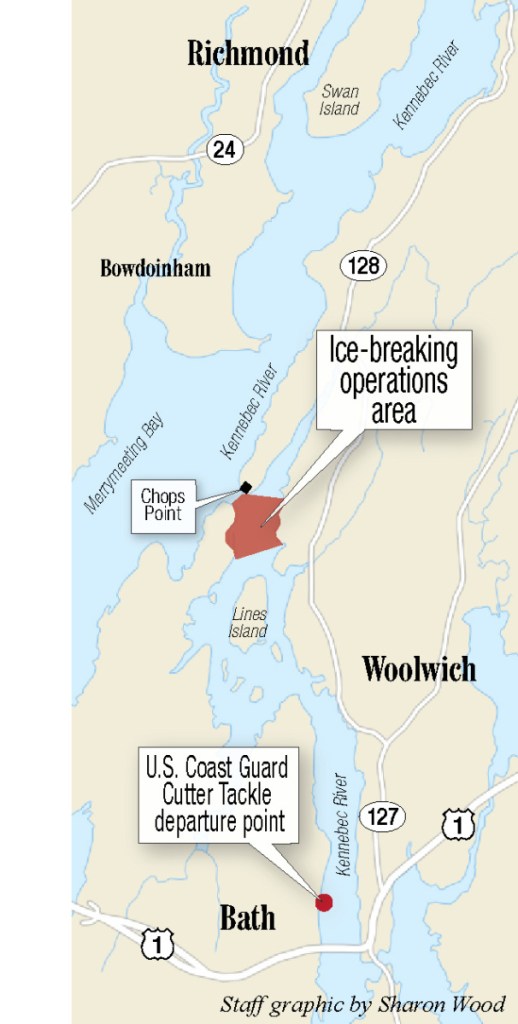ABOARD THE USCGC TACKLE — Two U.S. Coast Guard cutters took turns for nearly two hours Wednesday barreling full speed toward the only thing between them and the open water of the Kennebec River: thick sheets of ice.
Several times throughout the journey, as one of the vessels, the USCGC Tackle, reared up and approached the calm but imposing ice, Chief Petty Officer Lia Chasteen told her crew of six and the news media representatives aboard to “brace for impact.”
When the 65-foot cutter connected with the ice, its hull lifted slightly off the river as the bottom of the vessel cut through the thick expanse below the surface. The boat then thundered back down, and large blocks broke off and floated away. Other pieces of ice splintered and cracked as the weight of the boat became too much to bear.
The crew stayed calm, carrying on conversations even as the jolts came — strong enough to knock someone over or overboard if the person wasn’t careful and ready.
The two vessels — the Rockland-based Tackle and the Southwest Harbor-based USCGC Bridle — broke through nearly 350 yards of ice Wednesday morning on the southern Kennebec River and Merrymeeting Bay near Bowdoinham and Chop Point in Woolwich. It’s part of an unprecedented effort to increase water flow to help clear the ice jam in Farmingdale that wreaked havoc earlier this month in Hallowell and Augusta.
Chasteen said she was not aware of any previous ice-breaking operation on the Kennebec occurring this early in the year. The spring breakout usually happens in late March or early April. It didn’t happen the last two years, however, because warmer weather melted the ice before the Coast Guard was needed to break it.
With the ice broken Wednesday, Chasteen expects the cutters will make it farther up the Kennebec on Thursday. She said despite not reaching points farther north, any broken ice is a sign of progress for the ice-logged river, and the people affected by the flooding should feel good about the operation.
“While it’s slow, you have to be patient with the ice-breaking process,” Chasteen said. “Any break in the ice is positive relief for the river.”
The early arrival of the icebreakers comes as downtown Augusta and Hallowell remain vulnerable to midwinter river flooding like that caused by an ice jam on Jan. 13-14 that stranded many vehicles and sent icy water into businesses.
Shortly after 3 p.m. Wednesday, the Kennebec River was at 10.12 feet at the U.S. Geological Survey gauge at the Calumet Bridge at Old Fort Western in Augusta. Flood stage is 12 feet — and it had risen slowly since Monday before holding steady slightly above 10 feet Tuesday and into Wednesday.
The Coast Guard received a request a week ago from the Maine Emergency Management Agency to break out the ice on the Kennebec to ward off further flooding. The depth of the river and low height of the Pearl Harbor Remembrance Bridge linking Gardiner and Randolph limit the Coast Guard’s ability to reach the ice jam, but it will break ice to open up water downriver to improve the river flow, according to Lt. Matthew Odom, chief of the Coast Guard’s Waterways Management Division in Northern New England.
The National Weather Service in Gray issued a flood watch through early Wednesday morning and said flooding was possible from Tuesday into Wednesday, but the conditions that prompted the watch to be issued didn’t materialize.
Chasteen said water was flowing when the vessels came up the river Tuesday, but they encountered ice and didn’t make it as far as they did Wednesday. She said she doesn’t expect much re-freezing and the vessels should have a smoother path to the open part of the Kennebec on Thursday morning, when they will be joined by another 65-foot boat, the USCGC Shackle, and a 140-foot icebreaker called the USCGC Penobscot Bay.
“What you saw today was ramming and backing, a process in which we go full speed toward the ice and use the weight of the cutter to smash the ice underneath the hull,” Chasteen said. “The thickness of the ice and slush was preventing us from going any further.”
Chasteen said there was probably 16 inches of solid ice with 2 to 3 inches of snow on top. There was about 6 inches to 1 foot of slush underneath that made it difficult to break, she said.
“We probably had about 200 yards to go, but because of the tides in our window, we had to stop and ensure that what we did break flowed down the river,” she said.
If the cutters had had another two hours to break ice, Chasteen said, they would have reached the open part of the river and could have headed north toward the Maine Kennebec Bridge in Richmond and farther upriver, if possible. The next tide opening will be after sunset, and it’s too dangerous to break ice in the dark, she said.
The arrival of the Penobscot Bay cutter will be a welcome sight. The 140-foot ice breaker is longer and heavier, which is beneficial for the ramming and backing process, Chasteen said, but it also has a bubbler system that warms the water around the hull.
“It’s a huge benefit for them because they’re melting the ice around the hull, which lets them cut through the ice much quicker,” Chasteen said. “Once they do that, (the 65-foot cutters) will be able to do more work.
Normally, ice-breaking operations on the Kennebec don’t happen until the spring, and Chasteen said the Coast Guard is fully supportive of having to come back to break out the river again in the spring.
“For now, we’ll break it out and do what we can,” she said.
Jason Pafundi — 621-5663
Twitter: @jasonpafundiKJ
Send questions/comments to the editors.





Comments are no longer available on this story